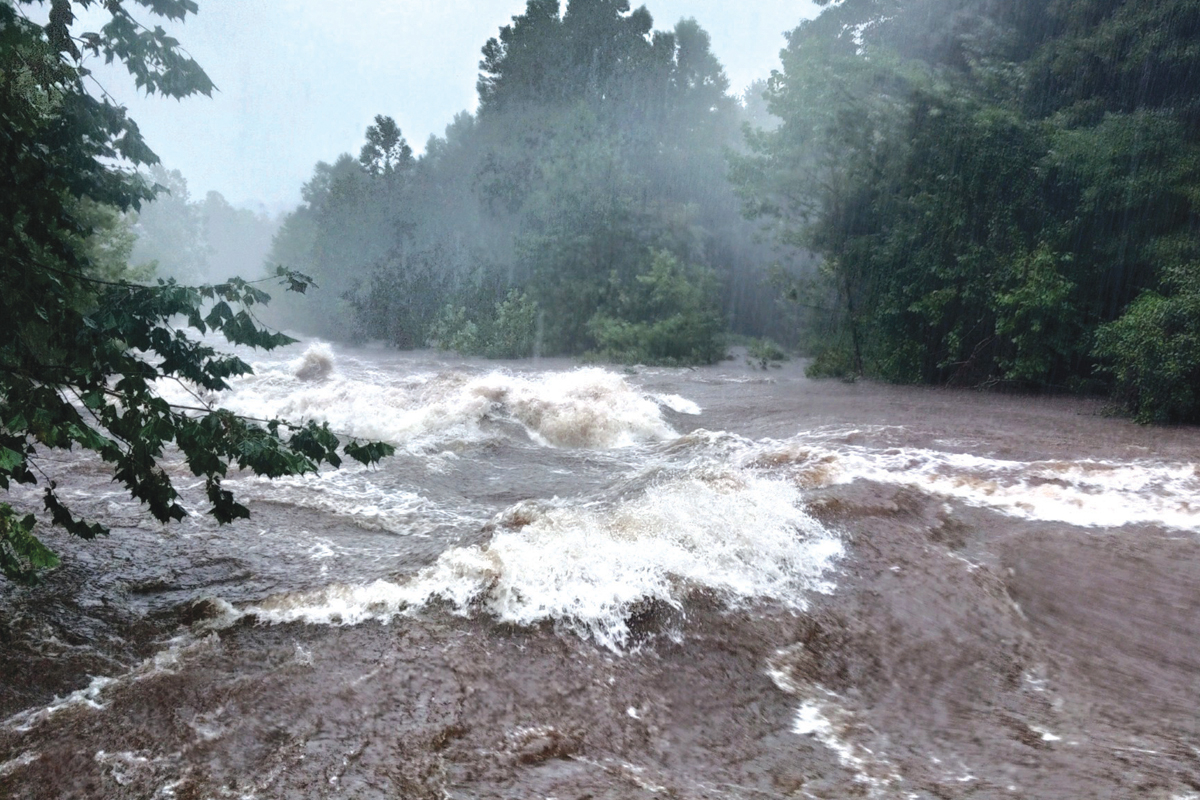Watershed restoration underway after 2021 flooding
 The East Fork of the Pigeon River on the afternoon of Aug. 17, a few hours before the river roared over its banks to cause deadly and destructive flooding. Scott McLeod photo
The East Fork of the Pigeon River on the afternoon of Aug. 17, a few hours before the river roared over its banks to cause deadly and destructive flooding. Scott McLeod photo
More than two years after flooding along the Pigeon River and its tributaries killed half a dozen people and destroyed businesses, cars and homes from its headwaters near the Blue Ridge Parkway on down through the towns of Canton and Clyde, contractors are set to begin some of the most intensive debris removal operations in Haywood County since the floods of 2004.
Phase one of the project is underway. To date, contractors have identified 121 debris removal sites, coordinated right-of-entry, classified those sites into eight distinct groups and awarded them to three contractors, all with the aim of removing vegetative and man-made debris from those sites.
Mark Cathey, vice president and regional manager of Asheville-based McGill Associates, said during an informational meeting attended by around 40 people at Crestview Baptist Church on Nov. 7 that the total length of the projects is more than 74,000 linear feet, or about 14 miles.
All along the way, contractors and engineers will pay particular attention to the needs of endangered species.
Khiya Armstrong, a project engineer with McGill, said the company had met with the U.S. Fish and Wildlife Service to discuss the “big list” of endangered species they may encounter, but two stuck out in her memory.
The Appalachian elktoe mussel has been listed as endangered since 1994. There were only two populations known in the world at the time, according to the Fish and Wildlife Service, but since then more have been located throughout the region.
Related Items
“They’re endemic here, they’re very unique to this area,” Anderson said. “We’ve been looking into if we’re going to be working in areas that are going to be impacting them. That was one of the biggest things that we were trying to pay attention to.”
The other was the northern long-eared bat. Although the bats are found in a majority of U.S. states and Canadian provinces, disease and habitat loss have a major impact on the species. During the year, the bats spend a lot of their time in forests, usually giving birth between May and July. Over the winter, the bats hibernate in caves, making them less likely to be disturbed by workers.
All work on phase one groups should be complete by March 7, 2024, according to Cathey’s presentation.
Work on group 8, performed by Southern Disaster Recovery, was scheduled to begin on Nov. 8 along the East Fork between Hungry Creek Road and Camp Hope.
Group 9, handled by Rock Creek Grading, starts just south of Camp Hope and proceeds south to the sweeping westward curve on Cruso Road. Work there was scheduled for Nov. 13-27.
On Nov. 27, work by Grillot Construction is set to begin on group 2, along Hominy Creek near Asheville Highway just east of Canton.
That same day, SDR will also begin work on groups, 5,6,7 and 10. Those sites begin just south of Laurel Bank Campground, where three people were killed, and progress north to just south of Springdale Resort. There’s an additional group of sites to the east, along Pisgah Creek.
The final phase one operations will also be conducted by SDR, in group 3, beginning Dec. 4. Work areas include sites west of Springdale, along the East Fork, up to the southern outskirts of Canton.
Cathey said the right-of-access process hasn’t been overly challenging, and that in five of the eight groups, they’ve had 100% cooperation. In the other three groups, it’s 70% to 85%.
“Most people understand that this is funding that’s available for the county, and they certainly want to maximize the use of it,” Cathey said.
Much of the work being performed in the phase one groups will be what’s called stream stabilization, which differs from stream restoration.
Stream restoration will be performed along with debris and sediment removal during phase two of the project, which is slated to take place from April 2024 through February 2025.
“In restoration, you develop the cross-section of the stream back to the pre-storm cross-section. In stabilization, lots of times you have to stabilize a stream bank in place without moving all of the debris that has shifted,” Cathey said. “Therefore, the cross-section of the river may be different after the work is done, whereas after [2004 flooding] a lot of that restoration occurred and we were able to develop the stream cross-section back to the original cross-section.”
The biggest challenge, Cathey said, will be in managing the project efficiently, to maximize results.
“With the stabilization efforts, relative to the 2005 funding, there was a lot more money available per foot of stream,” he said. “This time, there’s not restoration money as much as there is stabilization money.”
Questions about flood cleanup?
Efforts to restore Haywood County’s watershed by performing stream stabilization, restoration and debris removal in the aftermath of flooding two years ago will be an ongoing effort, likely through 2025. Work will be conducted at 121 sites, from Maggie Valley to Cruso, along 74,000 linear feet of streams and rivers — nearly 14 miles. If you have questions about flood cleanup on your property, email the Haywood County Soil and Water Conservation District at This email address is being protected from spambots. You need JavaScript enabled to view it. or call 828.452.2741, ext. 3.









